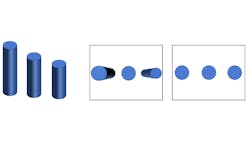Telecentric imaging for machine vision: A practical implementation overview
Telecentric lenses create an image in which all content is reproduced perpendicular (orthogonal) to the image plane. In a typical machine vision implementation, the plane of the front of the lens or the image sensor essentially represents the image plane—ignoring any small error in the sensor or lens mounting, or the use of a Scheimpflug adapter to purposely tilt the lens relative to the sensor.
The telecentric image is virtually free from all parallax—an inherent characteristic of all fixed-focal length (also called entocentric) lenses. An image with parallax is one in with an imaging angle imparted by the optics, just like with the human eye. With telecentric lenses, the zero angle telecentric image becomes indispensable in numerous machine vision applications.
Being a planar projection, the features in a telecentric image retain their geometric shape across the entire field of view and throughout the depth of field. Compare this effect to that of an entocentric lens image in these graphics showing a top-down view of simulated objects.
Parallax creates an effect of depth in the image and the surface features of the object become smaller at greater distances and elongated at the perimeter of the image. A telecentric image however reproduces the circles of the cylinders in this example without these effects.
Telecentric lenses can be designed as single sided, with either object space, or image space telecentricity. While these designs are useful in some applications, most telecentric optical systems offered for machine vision are bi-telecentric, having both image and object side telecentricity.
In the practical specification and application of telecentric lenses one must first consider some physical constraints:
To create a bi-telecentric lens, the front objective must be bigger than the specified field of view. While lenses can be constructed for very large fields of view, the size, weight, and cost quickly become unrealistic for most applications. Most off-the-shelf components are designed for fields of view less than 300 mm.
Magnification represents the key specification criteria for a telecentric lens. Magnification dictates the field of view that will be provided relative to a specific sensor size. Most designs feature a fixed magnification, so one must specify the correct magnification that delivers the desired field of view for the camera sensor selected. Apertures also are fixed in most telecentric lenses. Although some lenses with both aperture and magnification adjustment can be found, specification should focus on the target magnification and F#.
Telecentric lenses also function at a specific, specified working distance. Again, this is fixed by design and cannot be changed without modification to the configuration. Working distances for typical lenses can range from approximately 75 to 250 mm, though larger lenses may have working distances up to 450 mm or more. One impact of working distances, particularly small ones, can be in the configuration of correct illumination for the application. A large lens with a small working distance may limit the light component choices.
Finally, one last word about lighting with telecentric lenses. The zero-angle view might result in different behavior of typical LED light geometries than one would find when using a fixed focal length lens. As always, one should test an illumination concept for any application. One might also consider using telecentric illumination sources which—in some situations—can be useful in achieving greater contrast and other effects in telecentric imaging.
David Dechow is Principal Vision Systems Architect at Integro Technologies (Salisbury, NC, USA; www.integro-tech.com).
